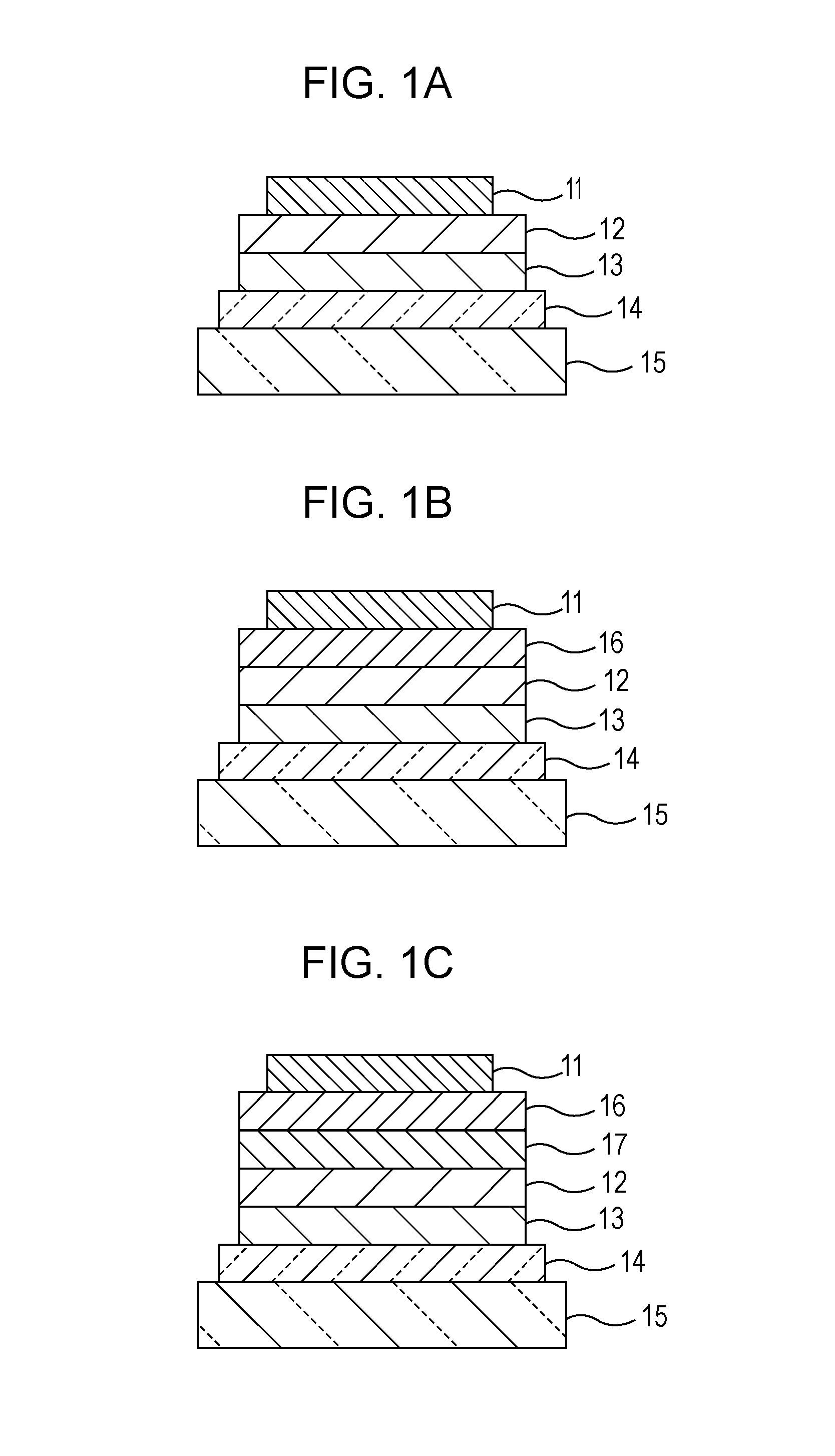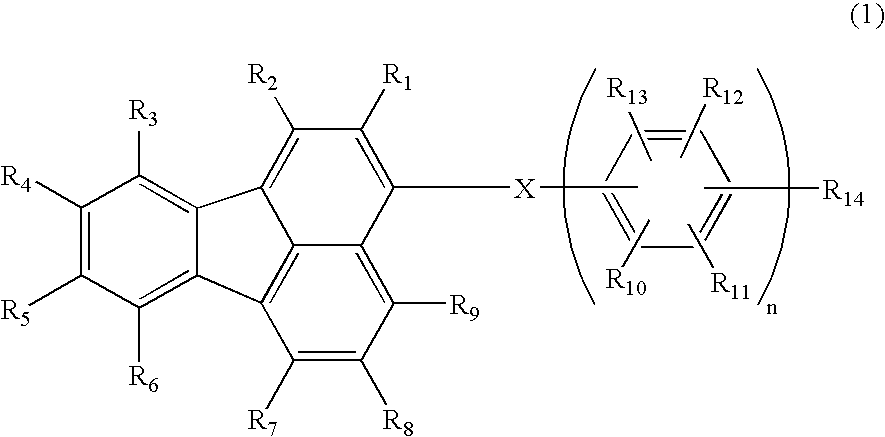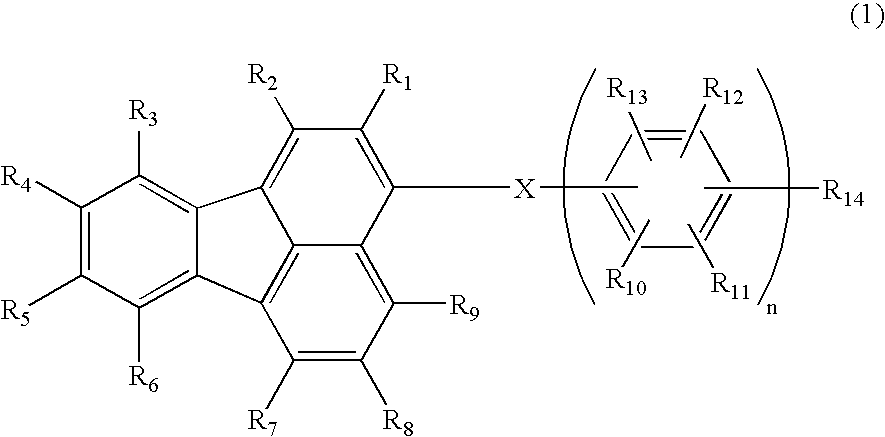Compound and organic light-emitting element
a light-emitting element and organic compound technology, applied in the direction of discharge tube luminescnet screen, other domestic articles, natural mineral layered products, etc., can solve the problems of affecting the material having entirely satisfactory light-emission luminance and durability, and the performance of the present device has not been satisfactory, etc., to achieve high efficiency and highly luminant light emission, easy manufacturing, and high durability
- Summary
- Abstract
- Description
- Claims
- Application Information
AI Technical Summary
Benefits of technology
Problems solved by technology
Method used
Image
Examples
example 1
Synthesis of Exemplified Compound No. D-2
[0053]
[0054]The compound 1-1 (manufactured by Aldrich Chemical Company, Inc.) in an amount of 344 mg (2 mmole), 566 mg (2 mmole) of the compound 1-2, 40.1 g of Pd (PPh3), 10 ml of toluene, 5 ml of ethanol, and 10 ml of an aqueous sodium carbonate solution at a concentration of 2 M were charged in an eggplant flask having a volume of 100 ml and were then stirred for 8 hours at 40° C. under a nitrogen stream. After the reaction was completed, crystals were obtained by filtration, followed by washing using water, ethanol, and toluene. The crystals thus obtained were dried by evacuation at 120° C., so that 340 mg (at a yield of 60%) of the compound 1-3 was obtained.
[0055]The compound 1-3 in an amount of 800 mg (2.44 mmole), 830 mg (2.68 mmole) of the compound 1-4, 40.05 g of Pd (PPh3), 10 ml of toluene, 5 ml of ethanol, and 10 ml of an aqueous sodium carbonate solution at a concentration of 2 M were charged in an eggplant flask having a volume of...
example 2
[0061]In this example, an element having the three organic layers shown in FIG. 1B was used. An ITO film having a thickness of 100 nm was patterned on a glass substrate. On this ITO substrate, the following organic layers and the electrode layer were sequentially formed in a vacuum chamber at a pressure of 10−5 Pa by vacuum evaporation using resistance heating so as to obtain a facing electrode area of 3 mm2.[0062]Hole transport layer (40 nm): Compound 2[0063]Light-emitting layer (50 nm): Compound 3 and the exemplified compound D-2 (weight ratio of 5%)[0064]Electron transport layer (25 nm): Compound 4[0065]Metal electrode layer 1 (0.5 nm): LiF[0066]Metal electrode layer 2 (100 nm): Al
[0067]As for properties of the EL element, current-voltage properties were measured by an ammeter 4140B manufactured by Hewlett-Packard Co., and the light emission luminance was measured by BM7 manufactured by Topcon Corp. It was confirmed that the element of this example is a blue light emission elemen...
example 3
[0068]An element was formed in a manner similar to that in Example 2 except that the exemplified compound No. D-1 was used instead of the exemplified compound No. D-2 of Example 2. The element of this example was a blue light emission element, and the luminance and the light emission efficiencies were 6.4 cd / A and 4.9 lm / W (at 400 cd / m2), respectively. In addition, the current density at an application voltage of 5 V was 39 mA / cm2.
PUM
| Property | Measurement | Unit |
|---|---|---|
| Nanoscale particle size | aaaaa | aaaaa |
| Nanoscale particle size | aaaaa | aaaaa |
| Nanoscale particle size | aaaaa | aaaaa |
Abstract
Description
Claims
Application Information
 Login to View More
Login to View More - R&D
- Intellectual Property
- Life Sciences
- Materials
- Tech Scout
- Unparalleled Data Quality
- Higher Quality Content
- 60% Fewer Hallucinations
Browse by: Latest US Patents, China's latest patents, Technical Efficacy Thesaurus, Application Domain, Technology Topic, Popular Technical Reports.
© 2025 PatSnap. All rights reserved.Legal|Privacy policy|Modern Slavery Act Transparency Statement|Sitemap|About US| Contact US: help@patsnap.com



